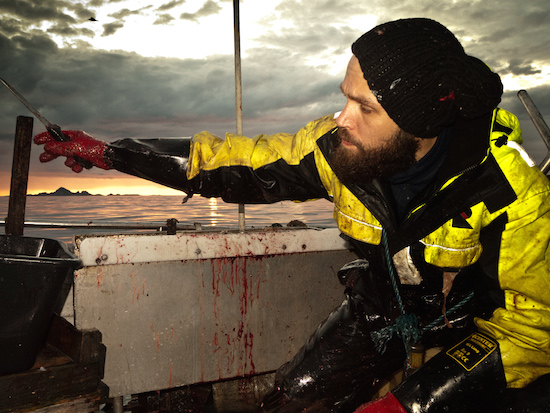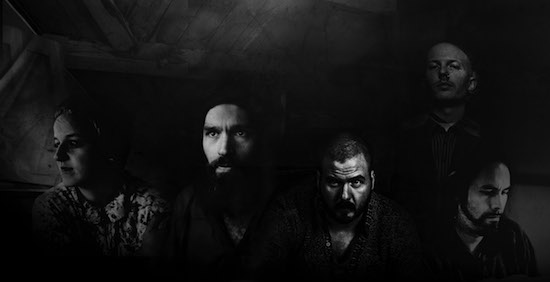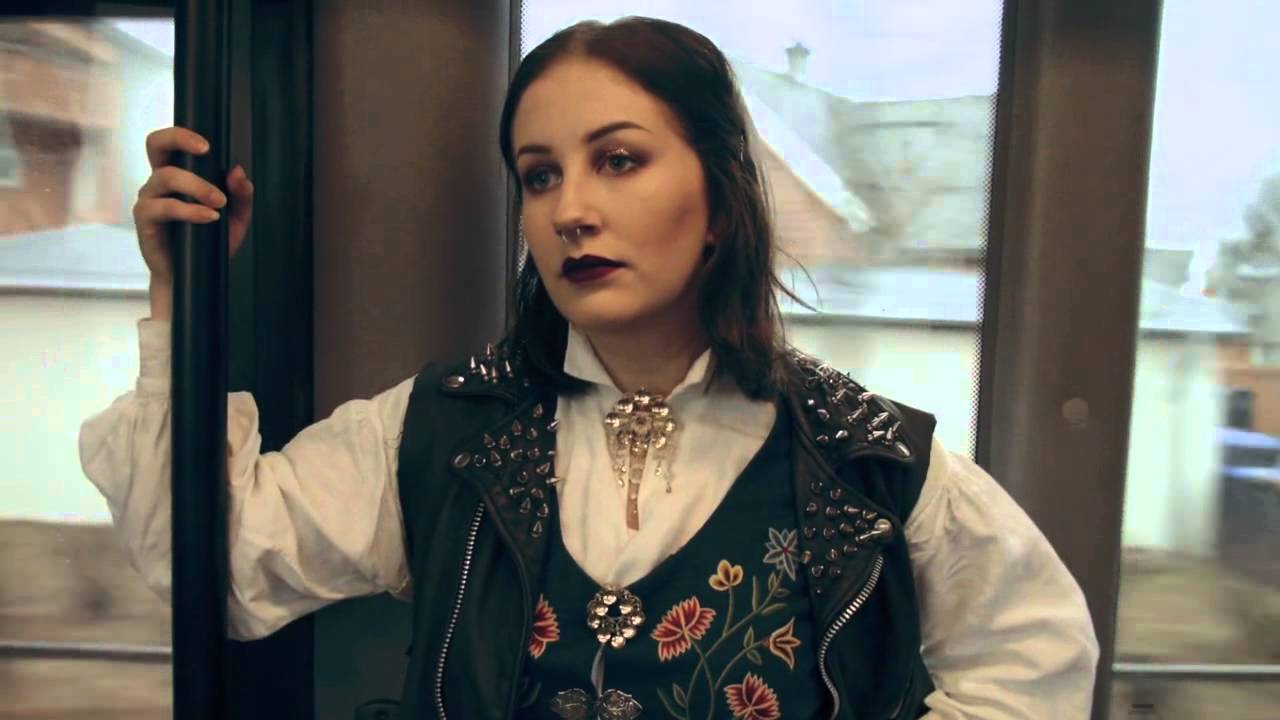"If the mountain won’t come to you, fuck the mountain," says Erling Ramskjell, often known in his native Norway as simply Æ. "We always have the sea." The heavily bearded, woollen-hatted singer and songwriter is talking about the Herculean tasks involved in putting together his latest project, Likholmen, something he calls "an audio-visual orchestra" and which he describes as "a maritime conflict between nu-troubadourism, folk and wry rock". It finds the cult musician collaborating with a number of his closest allies: the youthful, up-and-coming Ingeborg Oktober, his brother and longstanding musical partner Kåre Riibe Ramskjell, Hallstein Sandvin (a member of Hide Unas) and graphic designer Martin Losvik. Their debut, Lillelivet, takes the form not only of an album but also a striking 45-minute video filmed in and around Norway’s Træna archipelago, home to both Ramskjell and an annual music festival that has, over recent years, earned a reputation as, amongst other things, the world’s most remote and beautiful.
Both album and film celebrate a region that, legend has it, was formed after the gods threw rocks and reefs along the path to the North Star. Located some 80 miles down the coast from the nearest city, Bodø, on the edge of the Arctic Circle, the Træna municipality is famed for its wildlife, its fishing and the iconic, multi-peaked mountains on the island of Sanna, next door to Husøy, where Ramskjell lives. But Lillelivet acknowledges that, though the summer months see the islands’ remarkable landscapes bathed by the midnight sun, winter provides an inevitable flipside, its long, dark months and harsh weather making it far from hospitable. To non-Norwegian speakers, such subtleties might be lost – though the album’s twilit vulnerability provides plenty of evocative moments – but the film more than compensates, with rocks heaving and swirling against images of spectacular sunsets and archive footage of the place’s inhabitants.
In fact, the guttural sound of the local dialects echoes this contradictory environment: much as Jónsi’s sweet-toothed vocals for Sigur Rós have helped build an image of Iceland as elegantly windswept and magical, so Oktober’s and Ramskjell’s respectively innocent and sleepily gruff deliveries proffer a vision of a place both charming and hostile. It’s something Ramskjell has been doing for some time, slowly building up a reputation in Scandinavia through a series of releases under a variety of names, including Erling & The Armageddonettes (profiled two years ago by tQ editor John Doran, and whose album, Fraillaments, is reviewed here), but also as a solo artist (Æ) and, a decade ago, with the band Schtimm. A man blessed with an unusual approach to his work – he released one album as a USB stick shaped like a packet of pills, Spiritualised-style, while a limited edition live album arrived as another USB stick wrapped in wire – he also acted as a producer for Oktober’s debut album, Hjerteræk, and contributed vocals and lyrics to Bodø-based Hide Una’s second, recently released album Noishism, as well as collaborating and touring with noted Swedish singer-songwriter Stefan Sundström, who makes a cameo on Lillelivet.
In fact, Likholmen is something of a familial venture, not only due to Ramskjell’s blood relationship with his brother, but thanks to the ongoing creative collaboration Ramskjell has cultivated amongst these, and other, similarly minded musicians. Even graphic designer Losvik is closely tied to the region, having provided the Træna Festival with its visual identity from 2012 to 2014, and his film looks set to follow in the footsteps of Æ’s last video, ‘LÅT ALLA GAMLA DRÖMMAR DÖ’, which has just been nominated for a UK Music Video Award.
To celebrate the release of Lillelivet – and the Quietus’ video exclusive of the full accompanying film – we had a chat with Ramskjell about this fascinating project.
Can you tell me more about the various members of Likholmen?
Erling Ramskjell: We’ve known each other for quite some time, and, without being too hippie about it, we’re kind of a family, where we pursue both other projects and solo efforts, as well as coming together as Likholmen. Of course it’s all heart and soul when doing this. The term "hobby project" doesn’t exist in our world!
I grew up with Kåre, my brother in flesh. We’ve always done music, and have spent quite some time in crappy rehearsal rooms, shitty cars and, later on, in studios together and, of course, touring. We were both members of the band Schtimm, which released albums and toured quite a bit, especially in Germany, in the mid ’00s. I genuinely dislike the term ‘good musician’ – it sounds so boring and educated – but he has that rare gift of possessing musical empathy and intuition. In Likholmen, he’s armed with an old, battered reed organ and an electric piano.
I’ve known – and regularly played with – Ingeborg, despite her being only 20, for the last five years. She’s a truly original mind with an original voice, and a solid songwriter with good lyrics. She released an album and an EP last year that are both truly great. The future incarnate, she is. I had the honour of producing these together with Likholmen’s bassist, percussionist and electronics man, Hallstein, who spends his time producing other artists or sound engineering, as well as being the mastermind of guitar-based – but far from rock or indie – band Hide Unas. And Martin is a real master when it comes to aesthetics. He works with photography, video art, book illustrations and graphic design. He’s a visual poet with dark and primal inclinations. There’s also Stefan Sundström who’s on the track ‘Malströmsseglaren’ (‘The Maelstrom Sailor’). He’s a punked-up troubadour who is one great lyricist and songwriter. He’s a big name in Scandinavia, so there’s still some justice in the world.
Can you tell me how the project came together? What are its goals?
ER: Likholmen means Corpse Island in Norwegian, and it’s a little island I can see from my window. As the name indicates, back in the days it was used to store the deceased during the winter, before they could have a proper burial when spring came. And that’s a fine memento mori thing to have. Waking up every day, and thinking, "Hell, yeah, I’m still on the right side of the water". All the other band members have a strong connection to my island, and Losvik and I started conspiring one fine autumn day a few years ago while sitting on my porch, smoking cigarettes, watching the sea, and talking about life, death, the weather and, of course, the sea. We realised we had to do something together, and so we let our minds collectively wander off. Those thoughts matured for a while, lured the others on board, and we just started developing this little fictional micro universe, set in a maritime surrounding. And of course we borrowed the name from the real Likholmen.
Could you tell me more about the album?
ER: The big, important things in life are dealt with in a rather low-voiced, small-scale manner, in no way social realism, or postcard romanticism, but moods taken from our close surroundings. The title Lillelivet (Little Life) indicates this intimacy to all that everyday magic and ‘un-magic’. In the end, everything that’s big and mighty consists of very small parts. And I guess it’s in the little details, and the little things, that one can find the big mysteries. We’re not religious people, but the day you abandon spirituality, curiosity and the will to wonder, you’ve pretty much lost your humanness. Even the eternal and omnipotent sea consists of the same atoms as people, straw, rainbows and starfish. And, of course, closeness to nature, and the cycles in it, have a central place. We sing in Northern Norwegian, but Ingeborg and I have quite different dialects. So Likholmen can definitely be said to be rather North Norwegian, but of course not in a meaningless, nationalist, patriotic, tourist advert kind of way.
Where was the album recorded, and when?
ER: We found out that Træna was the only place both to record the album and to start out with the visuals. So we spent three days there in June, loading a reed organ, an electric piano and a few guitars into the local church, and recorded the whole thing pretty much live. It’s a rewarding yet hard way to work. Modern technology can be fantastic, but can also help you effectively kill all those small moments, twists and turns that occur during a recording. So-called perfection and correctness is truly overrated! There was a little flock of birds nesting in the walls of the church at the time we recorded, and you can hear them on the album. Hopefully they won’t claim any royalties.

Photograph courtesy of Wyndham Wallace
Tell me more about the film…
ER: It wasn’t the average "put some pictures to this music" approach. We had a dialogue going all the way, and had strong visions of what we wanted to depict musically, aesthetically and lyrically, as well as a clear direction. We leave those jam sessions to other people! Martin is the man behind all the visual stuff. He has hours of film, mainly shot here, but also from the whole of the north of Norway, which he then manipulated together into his storytelling and visual poetry.
Your last video as a solo artist, for ‘LÅT ALLA GAMLA DRÖMMAR DÖ’, has also just been nominated for a UK Music Video Award. How did this come about?
ER: Well, that’s a question I’ve been asking myself! Stefan Sundström told me my solo project should do a Swedish album, so I could come over to Sweden and tour with him. Norwegians understand Swedes much better than the other way around. And when Stefan Sundström, probably the nicest – and best – guy in Scandinavia, asks you to do something, you don’t hesitate. That’s how this director, Thor Brenne – who I’ve also known for decades – and I got the opportunity to work together. He’s done some really great videos, and thinks the way a video director should think: "Skip the lip-syncing artists, and the ass shaking. Tell some stories instead!"
Can we expect the band to perform outside of Norway?
ER: Even though we sing in North Norwegian, music and moving pictures are international languages that everyone can understand or sense. I guess the prerequisite you need for going to a Likholmen gig is a certain openness: that you don’t dislike music and video art, and … Yes, that’s pretty much it. So we hope we’ll get a shot at doing some gigs outside Norway. Hopefully someone picks us up one of these days and takes us abroad…
Lillelivet is out now on Clearpass and can be ordered digitally here or as a USB stick from propaganda@likholmen.no. For further details of Likholmen’s upcoming activity, head to their Facebook here



